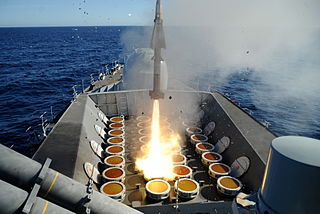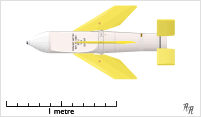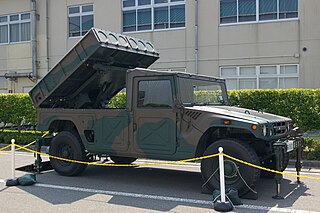Related Research Articles

A missile is an airborne ranged weapon capable of self-propelled flight aided usually by a propellant, jet engine or rocket motor.

An anti-tank guided missile (ATGM), anti-tank missile, anti-tank guided weapon (ATGW) or anti-armor guided weapon is a guided missile primarily designed to hit and destroy heavily armored military vehicles. ATGMs range in size from shoulder-launched weapons, which can be transported by a single soldier, to larger tripod-mounted weapons, which require a squad or team to transport and fire, to vehicle and aircraft mounted missile systems.

Rapier is a surface-to-air missile developed for the British Army to replace their towed Bofors 40/L70 anti-aircraft guns. The system is unusual as it uses a manual optical guidance system, sending guidance commands to the missile in flight over a radio link. This results in a high level of accuracy, therefore a large warhead is not required.

A wire-guided missile is a missile that is guided by signals sent to it via thin wires connected between the missile and its guidance mechanism, which is located somewhere near the launch site. As the missile flies, the wires are reeled out behind it. This guidance system is most commonly used in anti-tank missiles, where its ability to be used in areas of limited line-of-sight make it useful, while the range limit imposed by the length of the wire is not a serious concern.
Semi-automatic command to line of sight (SACLOS) is a method of missile command guidance. In SACLOS, the operator must continually point a sighting device at the target while the missile is in flight. Electronics in the sighting device and/or the missile then guide it to the target.
Manual command to line of sight is a method for guiding guided missiles.

The FGM-148 Javelin, or Advanced Anti-Tank Weapon System-Medium (AAWS-M), is an American-made man-portable anti-tank system in service since 1996, and continuously upgraded. It replaced the M47 Dragon anti-tank missile in US service. Its fire-and-forget design features automatic infrared guidance, allowing the user to seek cover immediately after launch, in contrast to wire-guided systems, like the system used by the Dragon, which require a user to guide the weapon throughout the engagement. The Javelin's high-explosive anti-tank (HEAT) warhead can defeat modern tanks by top-down attack, hitting them from above, where their armor is thinnest, and is also useful against fortifications in a direct attack flight. The javelin uses a tandem charge warhead to circumvent an enemy tank's explosive reactive armor (ERA) which would normally make HEAT warheads ineffective.

The BGM-71 TOW is an American anti-tank missile. TOW replaced much smaller missiles like the SS.10 and ENTAC, offering roughly twice the effective range, a more powerful warhead, and a greatly improved semi-automatic command to line of sight (SACLOS) that could also be equipped with infrared cameras for night time use.

Sea Wolf is a naval surface-to-air missile system designed and built by BAC, later to become British Aerospace (BAe) Dynamics, and now MBDA. It is an automated point-defence weapon system designed as a short-range defence against both sea-skimming and high angle anti-ship missiles and aircraft. The Royal Navy has fielded two versions, the GWS-25 Conventionally Launched Sea Wolf (CLSW) and the GWS-26 Vertically Launched Sea Wolf (VLSW) forms. In Royal Navy service Sea Wolf is being replaced by Sea Ceptor.

Seacat was a British short-range surface-to-air missile system intended to replace the ubiquitous Bofors 40 mm gun aboard warships of all sizes. It was the world's first operational shipboard point-defence missile system, and was designed so that the Bofors guns could be replaced with minimum modification to the recipient vessel and (originally) using existing fire-control systems. A mobile land-based version of the system was known as Tigercat.

Swingfire was a British wire-guided anti-tank missile developed in the 1960s and produced from 1966 until 1993. The name refers to its ability to make a rapid turn of up to ninety degrees after firing to bring it onto the line of the sighting mechanism. This means that the launcher vehicle could be concealed and the operator, using a portable sight, placed at a distance in a more advantageous firing position.

The FV102 Striker was the anti-tank guided missile carrier in the CVR(T) family and served in the British Army.

The Malkara was one of the earliest guided anti-tank missiles (ATGMs). It was jointly developed by Australia and the United Kingdom between 1951 and 1954, and was in service from 1958 until gradually replaced by the Vickers Vigilant missile in the late 1960s. It was intended to be light enough to deploy with airborne forces, yet powerful enough to knock out any tank then in service. The basic form was later adapted for the short-range surface-to-air role as the Seacat and influenced the development of the Ikara.

The MGM-166 LOSAT was a United States anti-tank missile system designed by Lockheed Martin to defeat tanks and other individual targets. Instead of using a high explosive anti-tank (HEAT) warhead like other anti-tank missiles, LOSAT employed a solid steel kinetic energy penetrator to punch through armor. The LOSAT is fairly light; it was designed to be mounted onto a Humvee light military vehicle while allowing the vehicle to remain air-portable. LOSAT eventually emerged on an extended-length heavy-duty Humvee with a hard-top containing four KEMs used by special operations. Although LOSAT never "officially" entered service, it was used for the smaller Compact Kinetic Energy Missile.

The Vickers Vigilant was a British 1960s era MCLOS wire-guided anti-tank missile used by the British Army. It was also licence-built in the United States by Clevite for the US Marine Corps, and sometimes known as Clevite rounds in this case.

The 9M14 Malyutka is a manual command to line of sight (MCLOS) wire-guided anti-tank guided missile (ATGM) system developed in the Soviet Union. It was the first man-portable anti-tank guided missile of the Soviet Union and is probably the most widely produced ATGM of all time—with Soviet production peaking at 25,000 missiles a year during the 1960s and 1970s. In addition, copies of the missile have been manufactured under various names by at least six countries.

The HJ-9, HongJian-9, military designation AFT-9, is an advanced, third-generation, man-portable or vehicle-mounted anti-tank guided missile system deployed by the People's Liberation Army Ground Force.

The General Dynamics Mauler was a self-propelled anti-aircraft missile system designed to a late 1950s US Army requirement for a system to combat low-flying high-performance tactical fighters and short-range ballistic missiles.

The FV1620 Humber Hornet was a specialised air-deployable armoured fighting vehicle designed to carry the Malkara, an anti-tank guided missile developed by Australia and the United Kingdom.

The Type 96 multi-purpose missile system (96式多目的誘導弾システム) is an anti-tank/landing craft missile used by the JGSDF. It is the first Japanese missile system to use a complete digitally controlled interface.
References
Citations
- 1 2 3 4 5 6 Lister 2020, p. 159.
- ↑ Suttie 2015, p. 116.
- ↑ Divine 1964, p. 226.
- ↑ French 2012, p. 228.
- ↑ Hansard 1960, p. 441.
- ↑ Lister 2020, p. 163.
Bibliography
- Elliott, Clive (2002). "Hornet FV1620" (PDF). Warwheels.net.
- Lister, David (2020). The Dark Age of Tanks: Britain's Lost Armour, 1945–1970. Pen and Sword Military. ISBN 9781526755179.
- Suttie, William (2015). Tank Factory: British Military Vehicle Development and the Chobham Establishment. History Press. ISBN 9780750963510.
- French, David (2012). Army, Empire, and Cold War: The British Army and Military Policy, 1945-1971. OUP Oxford. ISBN 978-0-19-954823-1.
- The Secretary of State for War (Mr. Christopher Soames) (9 March 1960), "Vote A. Number Of Land Forces", Parliamentary Debates (Hansard) , vol. 619, cc 439
- Divine, David (1964). The Blunted Sword. Hutchinson.